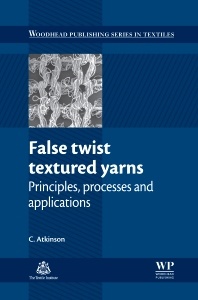False Twist Textured Yarns Principles, Processing and Applications Woodhead Publishing Series in Textiles Series
Auteur : Atkinson C

After an introductory chapter on the development of textured yarns, the book reviews yarn texturing machine designs and twist application methods, including air jet mingling and machine variants for draw textured speciality yarns. It also reviews common process performance and quality problems and how they can be resolved, as well process control, quality assurance and costs. The final chapters look at applications of false twist textured nylon, polyester and polypropylene yarns as well as the future of false twist texturing.
Based on the author?s extensive experience in the textile industry, False twist textured yarns is a standard reference on the key technologies and process issues involved in the manufacture of high-quality false twist textured yarns.
Woodhead Publishing Series in Textiles
Preface
Chapter 1: The development of textured yarns
Abstract:
1.1 Artificial silk: an early history
1.2 The arrival of melt spinning
1.3 The melt spinning process
1.4 Achieving desirable fabric properties through texturing
Chapter 2: Basic principles of false twist texturing
Abstract:
2.1 The concept of false twist texturing
2.2 The false twist mechanism
2.3 Twist application methods
Chapter 3: Yarn texturing machine design
Abstract:
3.1 The evolution of yarn texturing machines
3.2 Yarn heating and residence time in the primary texturing zone
3.3 Vapour phase heaters
3.4 High-temperature (HT) heaters
3.5 Intermediate-temperature heaters
3.6 Comparison summary of heater types
3.7 Yarn cooling in the texturing zone
3.8 Secondary heaters
3.9 Machine profiles
Chapter 4: Yarn twist application methods
Abstract:
4.1 Friction disc twisting
4.2 Friction disc materials
4.3 Influence of friction disc twisting parameters on texturing performance
4.4 Friction disc systems advances
4.5 Belt twisting
4 6 Improving yarn elasticity by torque generation (self twist)
Chapter 5: Process performance issues in yarn texturing
Abstract:
5.1 Friction and surface texture of yarn contact surfaces
5.2 Process instability: tension transients and speed limitations due to ‘surging’
5.3 Creel design and management
5.4 Package build specifications
5.5 Oil application systems
5.6 Automatic doffing systems
Chapter 6: Newer yarn texturing machine designs
Abstract:
6.1 Factors affecting machine design
6.2 Examples of new designs
Chapter 7: Air jet intermingling in yarn texturing
Abstract:
7.1 The concept of air jet intermingling
7.2 The intermingling process
7.3 Downstream process issues
Chapter 8: Optimisation of process parameters in yarn texturing
Abstract:
8.1 Influence of texturing parameters on yarn characteristics and performance
8.2 Single-position to plant-scale operation
8.3 Resolving process quality issues
Chapter 9: Draw textured yarn variants and speciality yarns
Abstract:
9.1 Double-density machines
9.2 Machine variants for draw textured speciality yarns
Chapter 10: Process control and quality assurance in yarn texturing
Abstract:
10.1 In-process controls
10.2 At yarn package doff
10.3 Laboratory controls
10.4 Final product inspection and packing
10.5 Statistical process control
Chapter 11: Process costs in yarn texturing operations
Abstract:
11.1 Factors affecting costs
11.2 Opportunities for yarn texturing outside low labour-cost countries
Chapter 12: End uses for draw textured yarns
Abstract:
12.1 Property benefits of textured yarns
12.2 Nylon
12.3 Polyester
12.4 Polypropylene
Chapter 13: The future of false twist texturing
Abstract:
13.1 Global production trends
13.2 Machine development
13.3 Process integration
13.4 Raw material yarns
Index
- Discusses the development of textured yarns, the basic principles of texturing and the process of false twist texturing
- Summarises the key principles, technologies and process issues in the manufacture of high-quality false twist textured yarns
- Chapters include texturing machine design, applications of textured yarns and the future opportunities for false twist texturing
Date de parution : 03-2012
Ouvrage de 224 p.
15.5x23.2 cm
